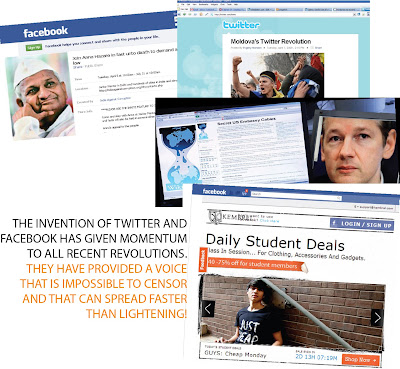Stop Marketing
As technology radically transforms interpersonal communication, the very tenets of marketing are getting redefined...
Aircel seems to have flooded the markets with its red and blue hoardings and kiosks dotting the whole city. They plastered Delhi with Mahendra Singh Dhoni’s smiling face, they stole the front page of the Times of India and changed it to “Move on India”. On 21st March, apart from TOI, Aircel had literally hijacked all Radio Channels & TV Channels with its advertisements. Many have used such “Ambush” marketing techniques earlier, however this time, Aircel did something else too. This Apollo Group-promoted brand went and connected itself with the youth – and where else to go other than Facebook. Aircel launched a voice message application on Facebook, which allowed friends to leave each other voice messages instead of just text messages. Within no time, it got 190 users to sign up for its voice mail application. Social networking sites are turning out to be lucrative options, where marketers can focus on their target groups, and that too, at very cheap rates.
Lets Face it!
Facebook has become a place where every college kid now hangs out. Its stickiness has improved with a user spending 190 minutes on an average on the site. Originally developed for college and university students, where you could log in only if you had a college e-mail id, Facebook is available to anyone with an email address today. So now there is an increase in the users of the 12-17 and 35+ demographic. So these social networking sites are attracting a lot of marketers, especially those who want to target the youth, for it’s the young who have typically more free time to spend on a social networking site. So if you can do something interesting & creative, which catches the fancy of young minds, you can create a “friendly buzz” about your brand; something very necessary for a brand’s survival and growth.
In Australia, when Nestle wanted to launch its new Kit Kat Chunky product targeted at teenage boys, it decided to not use any traditional media. According to its head of campaign marketing John Broome, five years ago, the advertising campaign would have included television, radio and outdoor; but today, things have changed. This time, the campaign includes a multi-player online game, online videos, mockumentaries (mock documentaries!!) and a mobile component to the website. With teenage boys spending, on an average, 13 hours a week playing games online, this was the perfect way to reach them. The advantage – if they liked you, they would refer you to their friends, who would like you too – ‘coz their friends told them so. Though overall, Nestle spends about 10% of its media budget on the internet, but this time, of the $1 million kept aside for launching Kit Kat Chunky, it decided to spend 70% of the amount on the internet. Nano, the latest offering from the Tatas to hit the Indian roads, broke new grounds in design, engineering and production processes. Now it’s using innovative ways to market and promote this unique Rs.1 lakh car. Unlike most small cars, Nano won’t advertise on TV. It will instead focus on online Nano games, Nano chat rooms, Nano pop-ups and even enter into a conversation with young users on Facebook, Orkut and blog spaces. Nano wants to be synonymous with anything “small, cute and brief” and it’s using the internet to help build this buzz about its brand, and probably this time, it’s not gone wrong, for the networking sites triggered a gushy response from people all over the world, asking for a similar car in their land too!
P&G, the world’s biggest advertiser, created a page on MySpace called “Miss Irresistible” to help market its Crest toothpaste. This way, it could connect with its users, potential users and along the way, gather market research. According to Wall Street, when the world’s biggest advertiser turns towards a new medium, a whole lot of others are bound to follow
If you want to market to the kids, you need to know where they live. When the giant US retailer Target wanted to promote its “back toschool” merchandise, it decided to sponsor a page on Facebook. No advertising of merchandise here – just conversing with the young people and getting to know them. The page was given a theme of “Dorm Survival Guide” where students were given advice on how to design their dorms, how to cook, how their furniture should match their personality – so there was a personality test too; and of course, it said how pillow cases, and comforters (available at Target too) could help make them more comfortable in their dorms. Initially, they included photos of dorms designed by designers, but you could upload your dorm pics too. It attracted more than 7,000 members, lots of photos, and lots of positive discussions about the brand. Target realised that on Facebook, you don’t sell first – you talk first. So it kept all discounts, promotions et al away from its Facebook page – and it worked. The community liked it.
JP Morgan Chase decided to market its credit cards with the help of Facebook and not its own website. To market to young people, you need to like them, and behave like them. You need to be relevant to their life. Its Facebook page gave advice to youngsters on how to use credit wisely, apart from earning points for joining Chase subgroups, et al.
Burger King created a page on MySpace and has more than 12,000 “friends”, who can post comments and get to know of various deals et al.
If you thought these social networking sites are being used by companies to peddle their goods, you are wrong. From Microsoft to Goldman Sachs to Deloitte, everyone is on these, building their own alumi networks to encourage their old employees to join back. Deloitte found that 20% of its new recruitments consisted of boomerangs – i.e people who had worked with it earlier. In today’s times, “Boomerangs” are a blessing. They know you, so it costs less to train them and they hit the ground running. Let’s face it – it’s difficult to stay away from Facebook & other such sites.
What are you doing now?
It seems like a mundane question – something you casually ask friends when you meet up – but it seems to have taken “netizens” by storm. This community is always looking for something exciting and new. Today it’s so very outdated to “Blog”. For netizens “it’s so 2004!” The new, fun and interesting buzz about the wires seems to be to “twitter”. Twitter. com seems to be the place where all the action is. With 1 million users and approximately 3 million messages posted daily, it seems to be the best combination of SMS and blogging. Its a simple concept – sounding ridiculous to many (especially the not-soyoung!). It was made with the idea of letting your friends and followers know what you are doing now – but it’s catapulted into a rage for its over simplicity and convenience. You can “twitter” with your mobile or computer and know what your friends are doing now!
At first it sounds silly – why would anyone be interested in what you are doing? Think abut it; when Dalai Lama “twittered”, it took His Holiness just two days to garner more than 20,000 followers. People twittered, “I’m sure HH will be as inquisitive about technology as he has been over the past 14 reincarnations.” Of course, it was soon discovered to be a hoax and temporarily suspended. Incidentally, “God” and “Satan” also have their accounts on Twitter. They are yet to be verified for authenticity, but marketers world over are not leaving this interesting field to try their luck with increasing market share. After all, Barack Obama “tweeted” to encourage people to vote in the US election – and won!
Huge brands are using Twitter to get close to customers like “Whole Foods Market asks its friends & followers what they like to read & watch and informs them of various events coming up.” Samsung uses Twitter to update you on latest company news. Southwest holds interesting discussions with its customers on Twitter; not necessarily related to travel. Comcast has put its service personnel’s photo on its Twitter account & he offers you any help or support you require. Home Depot, too, uses Twitter to offer alternate customer support.
Twitter has a character limit of 140 – which is its best feature. Short, snappy and easy to follow is what makes Twitter work. So if your brand is not Twittering, you may be left out. Dell, Starbucks, many NGOs, are all out there finding out what their customers are doing right now, and how to engage them in a profitable conversation.
Google is feeling the heat and till it cannot buy up Twitter, it is also using it to its best advantage. Now Google provides a service whereby marketers can send their five most recent Tweets across the AdSense network. Intuit is one of the first to experiment with it. It works like this – when you see the advertisement of Intuit’s Turbo Tax, you click on it and you go to the twitter page, not the company’s official website. The idea is not to drive direct sales but to get people to “follow” Intuit. Once you befriend them, you can convert many into loyal customers.
Marketing is changing. Marketing is, after all, about communicating, and the way people are communicating with each other is changing. So rules of the game have to change. No one wants to be “Marketed” to nowadays. So if you really want to make a headway into new markets, you gotta stop marketing & start talking.


Comments
Post a Comment